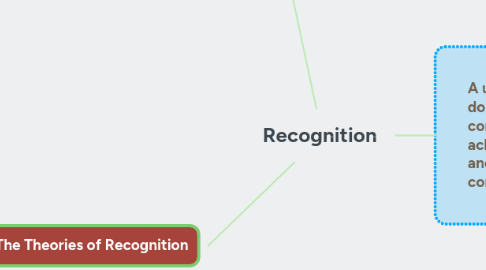
1. Groups of states according to their recognition policy
1.1. States that formally recognize governments
1.2. States that generally do not formally recognize governments but do so in exceptional circumstances for political reasons
1.3. States that formally recognize only States, not governments
2. The Theories of Recognition
2.1. Constitutive Theory of Recognition
2.1.1. Representatives
2.1.1.1. Oppenheim, Hegal and Anziloti
2.1.2. Ideas
2.1.2.1. Considers that the act of recognition by other States creates a new State and grants it the international legal personality. This implies that the new State is established as an international person by virtue of the will and consent of already existing States
2.1.2.2. In case of a new government, it is the recognition that grants it the status at the international level
2.1.3. Examples of this theory
2.1.3.1. Germany was divided into two parts after the World War II by a treaty
2.1.3.2. Korea was divided into two parts
2.1.4. Disadvantages
2.1.4.1. This theory is criticised because unless a state is recognised by other existing states, rights, duties and obligations of statehood community under International Law is not applicable to it
2.1.4.2. This theory also leads to confusion when a new state is acknowledged and recognised by some of the existing states and not recognised by other states.
2.2. Declaratory / Declarative Theory of Recognition
2.2.1. Representatives
2.2.1.1. Wigner, Hall, Fisher and Brierly
2.2.2. Ideas
2.2.2.1. According to this theory, any new state is independent of the consent by existing states
2.2.2.2. This theory states that the existence of a new state does not depend on being recognised by the existing state. Even before recognition by other states, the new state has the right to defend its integrity and independence under International law
2.2.3. Essentials for recognition as a state
2.2.3.1. 1. It should have a permanent population.
2.2.3.2. 2. A definite territory should be controlled by it.
2.2.3.3. 3. There should be a government of that particular territory.
2.2.3.4. 4. That entity should have the capacity to enter into relations with other states.
2.2.4. Example
2.2.4.1. Taiwan is a democratic country and its adjoining areas where Chinese territory. Although only few countries recognize Taiwan yet it had business dealings with almost every country.
2.2.5. Disadvantage
2.2.5.1. But the main disadvantage of declarative theory is that this theory fails to explain legal rights and consequent of a recognized state.
